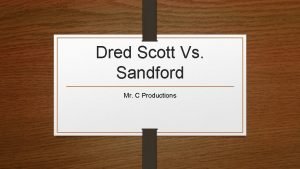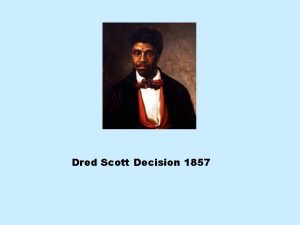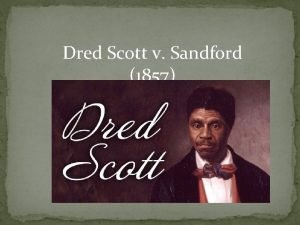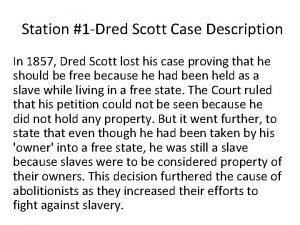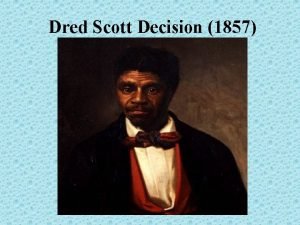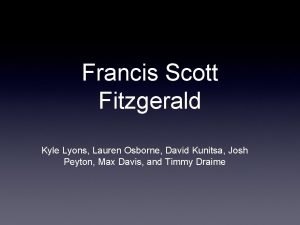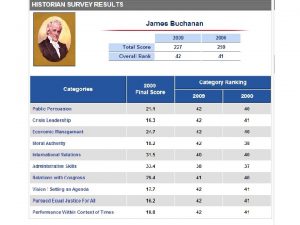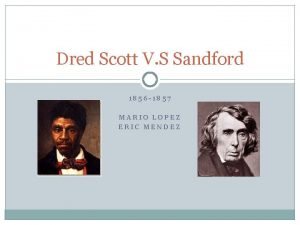DRED SCOTT VS SANDFORD 1857 Tyler Kennedy Nick








- Slides: 8

DRED SCOTT VS SANDFORD 1857 Tyler Kennedy Nick Logan

Dred Scott. Background Ø Born a slave to the Blow family Ø Sold to Army Surgeon named Dr. John Ø Ø Ø Ø Anderson Owner died then got a new owner Lived in Illinois (Free State at the time) Moved to Wisconsin which prohibited slavery after the Missouri Compromise Stayed a slave and married Taken to Louisiana where owner died After death Scott went to get freedom from the court (1846) Died on September 17 th, 1858 (age 63)

Scott vs Sandford Ø March 6 th, 1857 Ø Scott believed he was entitled to emancipation due to him living in Ø Ø Ø free states Chief Justice Roger B. Taney who was a supporter if slavery disagreed with Dred. The court decided that no black, free or slave, could claim U. S. citizenship, which meant blacks could not petition the court for freedom Taney used constitution as evidence and briefly mentioned Declaration of Independence Declared the Missouri Compromise as unconstitutional Stayed a slave until May 26 th, 1857 Case heightened tensions between the North and South, which erupted a war 3 years later ( south succeeds)

H: Happened March 6 th , 1857 after Scott sued the court for his right to be free. Held in the Supreme court. I: The intended audience was the officials of the Supreme Court to hear Dred’s claim. Also the intended audience was to black men and women who thought they were citizens. P: The purpose was to tell the court that since he lived in a free state with his master he should automatically be emancipated. Also he wanted his wife and son to be free since they were also living in a free state. P: The case showed two point of views, it showed Dred Scott’s which was that he should be emancipated due to him living in a free state, and Chief Justice Roger B. Taney who believed that blacks had no rights (pro slavery) and that the Missouri Compromise was unconstitutional. O: The idea that blacks are not equal to whites was used in the court case, this idea was used through out history. Some people today still believe this, but the idea that blacks can’t petition in a court of law is no longer used. S: The Missouri compromise (1820) stated that any states above the 36’ 30 line were free states (Wisconsin, Illinois), and the south succeeding from the union (1860 -1861) is also connected with the Dred Scott Decision.

THOMAS NAST'S "THE EMANCIPATION OF THE NEGROES, JANUARY 1863 --THE PAST AND THE FUTURE, " HARPER'S WEEKLY

The Emancipation of Negroes, January 1863, The past and the Future Ø Ø Ø Title mentions the past and the future: Left side shows past, the top shows the present, and the right side and the middle bubble show the future of slaves Small bubble in middle shows father time and the New Years baby freeing a slave ( reference to the Emancipation Proclamation which was published on January 1 st Left side shows slaves being beaten and sold, also shows a family being broken up Top shows confederates in retreat, cannons and smoke to symbolize a battle, the top right shows the union celebrating victory and a lady holding up a scale to symbolize Justice Right side shows black children going to school in peace, a black man receiving money from a bank, and a black man tipping his hat to a white man on a horse (could possibly foreshadow towards share cropping) Middle bubble shows a family together, the stove says Union, and there is a picture of Abraham Lincoln

H: Published January 24 1863, 23 days after Emancipation Proclamation to the popular political magazine Harpers Weekly I: Thomas Nast and his publisher wrote for the Union and mainly republicans P: Thomas Nast wanted to remind the union what they were fighting for. The image shows images of the recent past and the cruelty of slavery, while providing a vision into a future where freed slaves are thriving. P: Thomas Nast is a republican in the union, which meant he is against slavery O: At the civil war the union had a weak cause but the emancipation proclamation strengthened the cause morally S: Reconstruction era organizations like the Freedmen’s Bureau will help Nast’s vision come true but share cropping will prevent it

Resources http: //totallyhistory. com/dred-scott-v-sandford/ http: //www. rooseveltcpush. com/uploads/2/3/5/4/23544792/deed_sc ott. pdf http: //www. history. com/topics/black-history/dred-scott-case http: //www. rooseveltcpush. com/kp 5 -primary-sources. html
